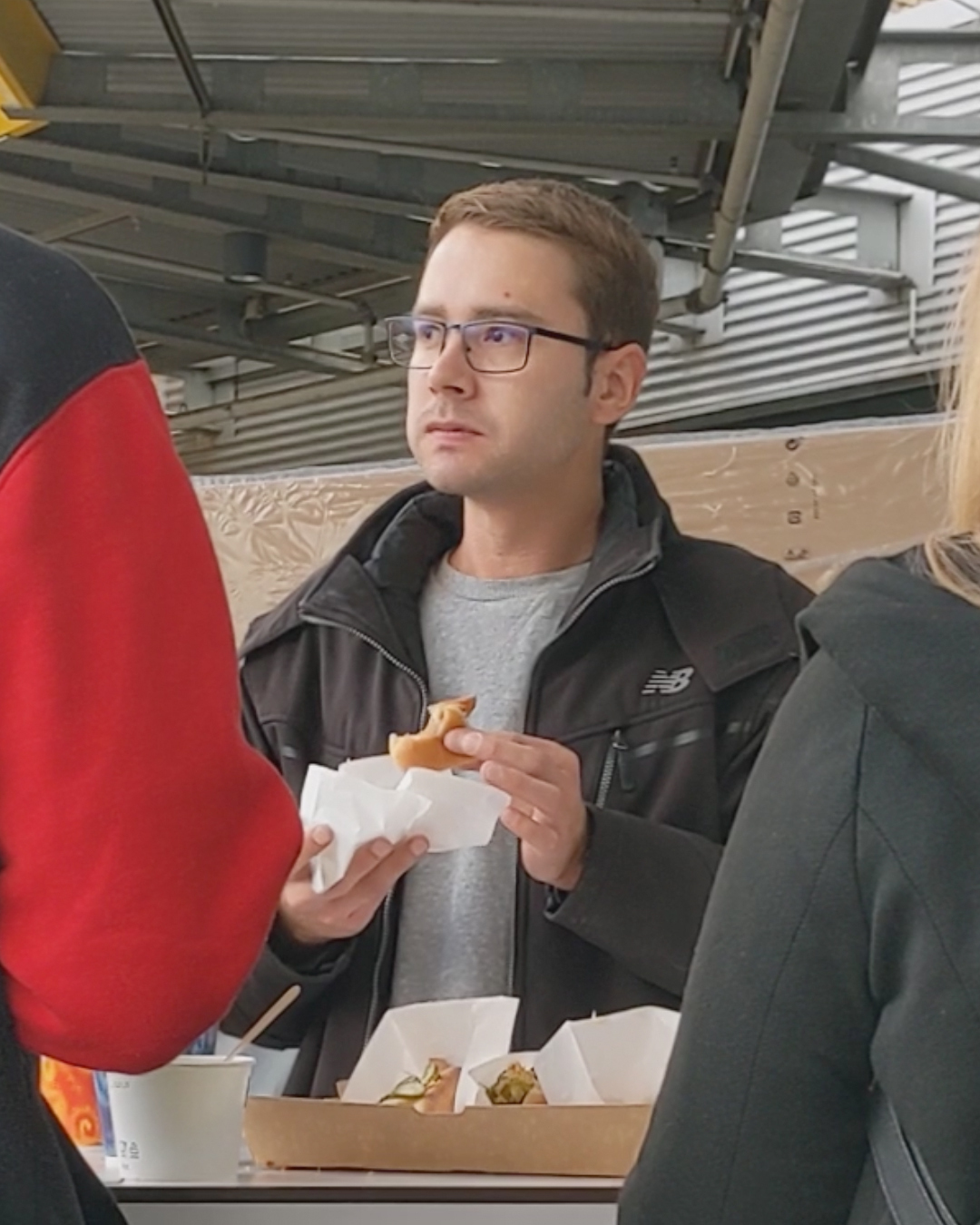Archive
null
KubaParis
REVIEW - BILLY BÄR - Vom sehen und fressen

Location
ScherbenText
Review
Sofia Leiby on Max Eulitz`s Billy Bär at Scherben, Berlin
My phone is full of pictures of strangers—eating, texting, waiting for the train. I’m fascinated by people, and my urge to document them and share it is still a bit undefined or obscure. What’s entertaining about a bunch of old ladies eating at Subway in the DC airport, because it’s the last restaurant available by our gate? How can they still eat, surrounded by all that lime green and that pervasive cottony artificial smell?
In Moyra Davey’s video Hemlock Forest (2016), she holds the camera steady in the train car in New York. At a seminar I attended with the artist she mused that what she’s doing is wrong: “I’m not supposed to film strangers.” She had to come up with a way to film them so they wouldn’t notice. It took her several tries to reproduce the scene shot by Babette Mangolte from Chantal Akermann’s News from Home (1977), where New Yorkers are filmed unknowingly on the subway, a shot that’s always fascinated her, she said. At one point in Davey’s film, a young boy in a private school uniform looks directly at the camera.
Max Eulitz also had to develop his own method—he would hold his phone low at an angle, as if he was taking a Facetime call, while chatting into a headphone speaker about meeting someone in thirty minutes, bobbing his head in a pantomime. Nobody noticed.
In these videos of Berliners chowing down on hotdogs in the parking lot of Ikea—chairless, crouching, finding a comfortable position in which to eat—they don’t notice their surroundings so much. Shopping is exhausting, especially at Ikea. You’re in the middle of nowhere, so there aren't many options for food. It’s a pandemic, so you’re eating outside. Max Eulitz films these customers in their least aware moments—like gazelles at a feeding ground, they’re vulnerable to his camera’s gaze in their ravenous consumption. At least in the gallery, he presents these videos in a narrow frame, at a small size, low to the floor. So we too must crouch to watch them eat, we too are framed by the glare of the parking lot’s harsh streetlights, which bookend the video frames.
Also from Ikea are the ubiquitous, white “Billy” shelves, hugging the wall of the high-ceilinged storefront gallery. The shelves, lacquered and inconspicuous, hold abstract lamps made of metal. These lamps, collected by Eulitz over the past year, were built by political prisoners during the GDR to emulate popular Scandinavian designs of the time and subsequently exported to make money. One might be more familiar with forced labor camps in China than prison labor in the West. This notion of political prisoners—imprisoned for protesting, spraying political graffiti, or spreading information—making bourgeoisie lamps is pretty novel. It all feeds into the fantasy of capitalism, that buying nice stuff makes one feel safe; and the GDR had to participate in this fantasy, because it was broke. Eulitz draws attention to the absurdity of all these realities, which violently collude into ours. Some of Ikea’s furniture is currently produced in Belarus, under “Europe’s last dictator” Alexander Lukashenko, for abysmal wages—allegedly just 360 euros a month for twelve hours of work a day.
Building onto this absurd theater is the very real fact that the patent owner of the “Berlin Buddy Bär,” Klaus Herlitz, happened one day to stroll by the gallery and notice the third element of the show: three two-tiered glass table-like sculptures held up by miniature plaster Bärs.
The Buddy Bear’s form—a depiction of a standing bear with its arms raised—was designed to represent a supposedly friendly, unified and open-for-business Berlin, at a time when the city was poor and craving investment. Coinciding with the sale of large swaths of public land to private companies in the late 90s, these creatures conquered the whole city, spreading, according to their maker, the late philanthropist Eva Herlitz, "tolerance and understanding throughout the world by their very existence."
Hence, Herlitz, one of the richest persons in Germany, widower of the late Eva Herlitz, proceeded to sue the gallery. This was settled by deciding that the Bärs would be destroyed after the show, although Herlitz’s lawyers claimed the “damage to the brand” had already been done—to the tune of approximately 100,000 Euro. Another layer comes on top now: cultural capital accounts for brand damage, which is sort of funny, since it usually works the other way around. This makes Eulitz’s work sort of punk. This slippage between tourist trinket and subversive art work makes the sculptures intriguing too, although they seem a bit blank holding nothing at all (perhaps that’s the point).
Eulitz’s show treads a fine line at animating all these formal delicacies of urban, semio-capitalized life, in a refreshing presentation that addresses its context, past and present, without overly moralizing. After the show, the cuddly plaster Buddy Bears were duly destroyed with a sledgehammer by the gallerist.














Sofia Leiby